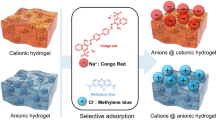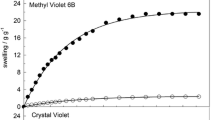Abstract
An amphiphilic cationic dextran hydrogel with quaternary ammonium pendent groups was prepared, and its performances in adsorption of anionic dyes were studied as a function of pH, contact time, initial dye concentration, dye type, and temperature and evaluated by equilibrium, kinetic, and thermodynamic analysis. Adsorption equilibrium data fitted well with Langmuir model over the entire range of dyes’ concentrations, while Freundlich model was appropriate only after 30–60% of gel cationic sites were occupied by dye molecules. Pseudo-second-order kinetic model was the best fit for the experimental data. The values of calculated adsorption thermodynamic parameters and activation energies suggest an adsorption process governed by diffusion (Rose Bengal), chemisorption (Indigo Carmine), or combined physical and chemical interactions (Methyl Orange and Orange II). The maximum adsorption capacity of dextran hydrogel for anionic dyes was in the range 650–730 mg/g and depended on dye chemical structure and molecular weight. The most rapid desorption of Methyl Orange from the dye-loaded hydrogel was achieved under dynamic conditions with a successive addition of water, NaCl 0.5 M, and methanol as eluents.








Similar content being viewed by others
References
Tan KB, Vakili M, Horri BA, Poh PE, Abdullah AZ, Salamatinia B (2015) Adsorption of dyes by nanomaterials: recent developments and adsorption mechanisms. Sep Purif Technol 150: 229–242
Yagub MT, Sen TK, Afroze S, Ang HM (2014) Dye and its removal from aqueous solution by adsorption: a review. Adv Colloid Interf Sci 209:172–184
Ahmad A, Mohd-Setapar SH, Chuong CS, Khatoon A, Wani WA, Kumar R, Rafatullah M (2015) Recent advances in new generation dye removal technologies: novel search for approaches to reprocess wastewater. RSC Adv 5:30801–30818
Forgacs E, Cserháti T, Oros G (2004) Removal of synthetic dyes from wastewaters: a review. Environ Int 30:953–971
Gupta VK, Mittal A, Jharec D, Mittal J (2012) Batch and bulk removal of hazardous colouring agent Rose Bengal by adsorption techniques using bottom ash as adsorbent. RSC Adv 2:8381–8389
Gupta VK, Suhas (2009) Application of low-cost adsorbents for dye removal—a review. J Environ Manag 90:2313–2342
El Qada EN, Allen SJ, Walker GM (2008) Influence of preparation conditions on the characteristics of activated carbons produced in laboratory and pilot scale systems. Chem Eng J 142:1–13
Mezohegyi G, van der Zee FP, Font J, Fortuny A, Fabregat A (2012) Towards advanced aqueous dye removal processes: a short review on the versatile role of activated carbon. J Environ Manag 102:148–164
Inyang M, Dickenson E (2015) The potential role of biochar in the removal of organic and microbial contaminants from potable and reuse water: a review. Chemosphere 134:232–240
Alver E, Metin AU (2012) Anionic dye removal from aqueous solutions using modified zeolite: adsorption kinetics and isotherm studies. Chem Eng J 200–202:59–67
Dogan M, Karaoglu MH, Alkan M (2009) Adsorption kinetics of maxilon yellow 4GL and maxilon red GRL dyes on kaolinite. J Hazard Mater 165:1142–1151
Haque E, Jun JW, Jhung SH (2011) Adsorptive removal of methyl orange and methylene blue from aqueous solution with a metal-organic framework material iron terephthalate (MOF-235). J Hazard Mater 185:507–511
Panic VV, Velickovic SJ (2014) Removal of model cationic dye by adsorption onto poly(methacrylic acid)/zeolite hydrogel composites: kinetics equilibrium study and image analysis. Sep Purif Technol 122:384–394
Rojas Garcia E, Lopez Medina R, May Lozano M, Hernández Perez I, Valero MJ, Maubert Franco AM (2014) Adsorption of azo-dye orange II from aqueous solutions using a metal-organic framework material: iron-benzenetricarboxylate. Materials 7:8037–8057
Anastopoulos I, Kyzas GZ (2014) Agricultural peels for dye adsorption: a review of recent literature. J Mol Liq 200: 381–389
Fang R, He W, Xue H, Chen W (2016) Synthesis and characterization of a high-capacity cationic hydrogel adsorbent and its application in the removal of Acid Black 1 from aqueous solution. React Funct Polym 102:1–10
Panic VV, Madzarevic ZP, Volkov-Husovic T, Velickovic SJ (2013) Poly(methacrylic acid) based hydrogels as sorbents for removal of cationic dye basic yellow 28: kinetics equilibrium study and image analysis. Chem Eng J 217:192–204
Patel YN, Patel MP (2013) Adsorption of azo dyes from water by new poly (3-acrylamido propyl)-trimethylammonium chloride-co-N,N-dimethylacrylamide superabsorbent hydrogel—equilibrium and kinetic studies. J Environ Chem Eng 1:1368–1374
Van Tran V, Park D, Lee YC (2018) Hydrogel applications for adsorption of contaminants in water and wastewater treatment. Environ Sci Pollut Res 25:24569–24599
Vivek AV, Dhamodharan R (2008) Amphiphilic polystyrene-graft-poly (NN-dimethylamino-2-ethyl methacrylate) hydrogels synthesized via room temperature ATRP: studies on swelling behaviour and dye sorption. React Funct Polym 68:967–973
Blackburn R (2004) Natural polysaccharides and their interactions with dye molecules: applications in effluent treatment. Environ Sci Technol 38: 4905–4909
Crini G, Badot PM (2008) Application of chitosan a natural aminopolysaccharide for dye removal from aqueous solutions by adsorption processes using batch studies: a review of recent literature. Progr Polym Sci (Oxford) 33:399–447
Kyzas GZ, Lazaridis NK, Kostoglou M (2014) Adsorption/desorption of a dye by a chitosan derivative: experiments and phenomenological modeling. Chem Eng J 248:327–336
Singh V, Sharma AK, Tripathi DN, Sangh R (2009) Poly(methylmethacrylate) grafted chitosan: an efficient adsorbent for anionic azo dyes. J HazardMater 161:955–966
Abdel-Halim ES (2013) Preparation of starch/poly(NN-diethylaminoethyl methacrylate) hydrogel and its use in dye removal from aqueous solutions. React Funct Polym 73:1531–1536
Cheng R, Ou S, Li M, Li Y, Xiang B (2009) Ethylenediamine modified starch as biosorbent for acid dyes. J Hazard Mater 172:1665–1670
Jin L, Li WG, Xu QH, Sun QC (2015) Amino-functionalized nanocrystalline cellulose as an adsorbent for anionic dyes. Cellulose 22:2443–2456
Jin L, Sun Q, Xu Q, Xu Y (2015) Adsorptive removal of anionic dyes from aqueous solutions using microgel based on nanocellulose and polyvinylamine. Bioresour Technol 197:348–355
Pei A, Butchosa N, Berglund LA, Zhou Q (2013) Surface quaternized cellulose nanofibrils with high water absorbency and adsorption capacity for anionic dyes. Soft Matter 9:2047–2055
Karthika JS, Vishalakshi B (2015) Novel stimuli responsive gellan gum-graft-poly(DMAEMA) hydrogel as adsorbent for anionic dye. Int J Biol Macromol 81:648–655
Constantin M, Asmarandei I, Harabagiu V, Ghimici L, Ascenzi P, Fundueanu G (2013) Removal of anionic dyes from aqueous solutions by an ion-exchanger based on pullulan microspheres. Carbohyd Polym 91:74–84
Cho E, Tahir MN, Kim H, Yu J-H, Jung S (2015) Removal of methyl violet dye by adsorption onto N-benzyltriazole derivatized dextran. RSC Adv 5:34327–34334
Demirbilek C, Dinc CO (2016) Diethylaminoethyl dextran/epichlorohydrin (DEAE-D/ECH) hydrogel as adsorbent for murexide. Desalin Water Treat 57:6884–6893
Stanciu MC, Nichifor M (2018) Influence of dextran hydrogel characteristics on adsorption capacity for anionic dyes. Carbohyd Polym 199:75–83
Mocanu G, Nichifor M (2014) Cationic amphiphilic dextran hydrogels with potential biomedical applications. Carbohyd Polym 99:235–241
Nichifor M, Cristea D, Mocanu G, Carpov A (1998) Aminated polysaccharides as bile acid sorbents: in vitro study. J Biomater Sci Polym Ed 9:519–534
Nichifor M, Stanciu MC, Simionescu BC (2010) New cationic hydrophilic and amphiphilic polysaccharides synthesized by one pot procedure. Carbohyd Polym 82:965–975
Pepper K, Reichenberg D, Hale DK (1952) Properties of ion- exchange in relation to their structure. Part IV: swelling and shrinkage of sulphonated polystyrenes of different cross-linking. J Chem Soc 3:129–3136
Dragan SE, Humelnicu D, Dinu MV (2018) Design of porous strong base anion exchangers bearing NN-dialkyl 2-hydroxyethyl ammonium groups with enhanced retention of Cr(VI) ions from aqueous solution. React Funct Polym 124:55–63
Tang SCN, Wang P, Yin K, Lo IMC (2010) Synthesis and application of magnetic hydrogel for Cr (VI) removal from contaminated water. Environ Eng Sci 27:947–954
Kavitha D, Namasivayam C (2007) Experimental and kinetic studies on methylene blue adsorption by coir pith carbon. Bioresour Technol 98:14–21
Ma Q, Shen F, Lu X, Bao W, Ma H (2013) Studies on the adsorption behavior of methyl orange from dye wastewater onto activated clay. DesalinWater Treat 51:3700–3709
Acemioglu B (2004) Adsorption of Congo red from aqueous solution onto calcium-rich fly ash. J Colloid Interf Sci 274:371–379
Foo KY, Hameed BH (2010) Insights into the modeling of adsorption isotherm systems. Chem Eng J 156:2–10
Giles CH, MacEwans TH, Nakhwa N, Smith D (1960) Studies in adsorption. Part XI. A system of classification of solution adsorption isotherms and its use in diagnosis of adsorption mechanisms and in measurement of specific surface areas of solids. J Chem Soc:3973–3993
Langmuir I (1916) The constitution and fundamental properties of solids and liquids. Part I. Solids. J Am Chem Soc 38:2221–2295
Freundlich HMF (1906) Over the adsorption in solution. J Phys Chem 57:1100–1107
Dubinin MM, Zaverina ED, Radushkevich LV (1947) Sorption and structure of active carbons. J Phys Chem 21:1351–1362 (in Russian)
Zheng H, Liu D, Zheng Y, Liang S, Liu Z (2009) Sorption isotherm and kinetic modeling of aniline on Cr-bentonite. J Hazard Mater 167:141–147
Li M, Wang Z, Li B (2015) Adsorption behaviour of congo red by cellulose/chitosan hydrogel beads regenerated from ionic liquid. DesalinWater Treat 57:16970–16980
Peng X, Hu X, Fu D, Lamb FLY (2014) Adsorption removal of acid black 1 from aqueous solution using ordered mesoporous carbon. Appl Surf Sci 294:71–80
Güzel F, Saygli H, Saygli GA, Koyuncu F (2014) Elimination of anionic dye by using nanoporous carbon prepared from an industrial biowaste. J Mol Liq 194:130–140
Moura ALA, de Oliveira LK, Ciuffi KJ, Molina EF (2015) Influence of the hydrophilic/ hydrophobic nature of polyetheramines on the interaction between amine–alcohol–silicate hybrids and anionic dyes for effective water cleaning. J Mater Chem A 3:16020–16032
Yusuf M, Khan MA, Otero M, Abdullah EC, Hosomi M, Terada A, Riya S (2017) Synthesis of CTAB intercalated graphene and its application for the adsorption of AR265 and AO7 dyes from water. J Colloid Interf Sci 493:51–61
Zhang J, Zhou Q, Ou L (2012) Kinetic isotherm and thermodynamic studies of the adsorption of methyl orange from aqueous solution by chitosan/alumina composite. J Chem Eng Data 57:412–419
Zolgharnein J, Bagtash M, Asanjarani N (2014) Hybrid central composite design approach for simultaneous optimization of removal of alizarin red S and indigo carmine dyes using cetyltrimethylammonium bromide-modified TiO2 nanoparticles. J Environ Chem Eng 2:988–1000
Dragan ES, Mayr J, Häring M, Cocarta AI, Diaz Diaz D (2016) Spectroscopic characterization of azo dyes aggregation induced by DABCO-based ionene polymers and dye removal efficiency as a function of ionene structure. ACS Appl Mater Interf 8:30908–30919
Chiou MS, Ho PY, Li HY (2004) Adsorption of anionic dyes in acid solutions using chemically cross-linked chitosan beads. Dyes Pigments 60:69–84
Yan L, Shuai Q, Gong X, Gu Q, Yu H (2009) Synthesis of microporous cationic hydrogel of hydroxypropyl cellulose (HPC) and its application on anionic dye removal. Clean 37:392–398
Ho Y-S (2006) Review of second-order models for adsorption systems. J Hazard Mater B 136:681–689
Weber W, Morris J (1963) Kinetics of adsorption on carbon from solution. J Sanit Eng Div Am Soc Civ Eng 89:31–60
Jung K-W, Choi BH, Ahn K-H, Lee S-H (2017) Synthesis of a novel magnetic Fe3O4/Al2O3 hybrid composite using electrode-alternation technique for the removal of an azo dye. Appl Surf Sci 423:383–393
Chiou MS, Li HY (2003) Adsorption behavior of reactive dye in aqueous solution on chemical cross-linked chitosan beads. Chemosphere 50:1095–1105
Gu B, Schmitt J, Chen Z, Liang L, McCarthy JF (1994) Adsorption and desorption of natural organic matter on iron oxide: mechanisms and models. Environ SciTechnol 28:38–46
Liu Y, Liu Y-J (2008) Biosorption isotherms kinetics and thermodynamics. Sep Purif Technol 61:229–242
Anirudhan TS, Radhakrishnan PG (2008) Thermodynamics and kinetics of adsorption of Cu(II) from aqueous solutions onto a new cation exchanger derived from tamarind fruit shell. J Chem Thermodyn 40: 702–709
Funding
This work was supported by a grant of Romanian Ministry of Research and Innovation, CNCS - UEFISCDI, project number PN-III-P4-ID-PCE-2016-0519, within PNCDI III.
Author information
Authors and Affiliations
Corresponding author
Ethics declarations
Conflict of interest
The authors declare that they have no conflict of interest.
Electronic supplementary material
Optical images of the gel in dry and swollen states, plots of equilibrium adsorption, kinetic and thermodynamic data according to different models. Table summarizing adsorption performances reported for other sorbents.
ESM 1
(PDF 247 kb)
Rights and permissions
About this article
Cite this article
Stanciu, M.C., Nichifor, M. Adsorption of anionic dyes on a cationic amphiphilic dextran hydrogel: equilibrium, kinetic, and thermodynamic studies. Colloid Polym Sci 297, 45–57 (2019). https://doi.org/10.1007/s00396-018-4439-z
Received:
Accepted:
Published:
Issue Date:
DOI: https://doi.org/10.1007/s00396-018-4439-z




